Alternative Assessment Report: Economics of Consumer Behavior, UGB 109
VerifiedAdded on 2022/12/30
|14
|3533
|20
Report
AI Summary
This economics report, prepared as an alternative assessment for UGB 109, comprehensively examines key macroeconomic and microeconomic principles. The report begins with an introduction to macroeconomics and microeconomics, setting the stage for a detailed exploration of consumer behavior, contrasting cardinal and ordinal utility approaches. It then delves into the concept of elasticity, analyzing its different types and evaluating its practical usefulness in economic analysis. The report further investigates short-run costs, outlining various cost categories and analyzing the equilibrium conditions for both competitive and monopolistic firms. Additionally, the report addresses the crucial topics of inflation, discussing its causes, costs, and impacts on individuals and the economy. Finally, it explores the components of aggregate demand and their relationship to Gross Domestic Product (GDP), providing a holistic understanding of economic dynamics. The report concludes with a concise summary of the key findings and references supporting the analysis.
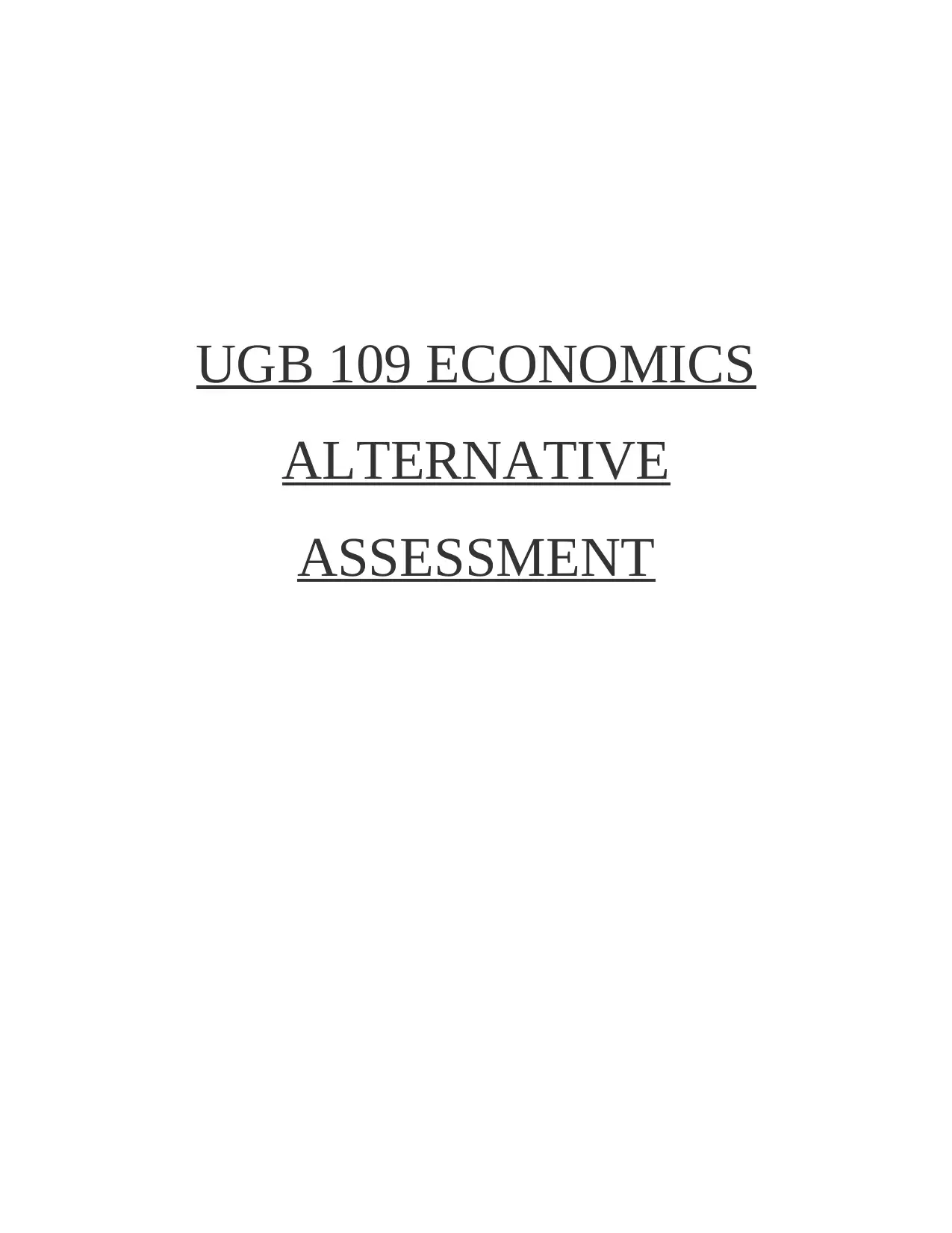
UGB 109 ECONOMICS
ALTERNATIVE
ASSESSMENT
ALTERNATIVE
ASSESSMENT
Paraphrase This Document
Need a fresh take? Get an instant paraphrase of this document with our AI Paraphraser
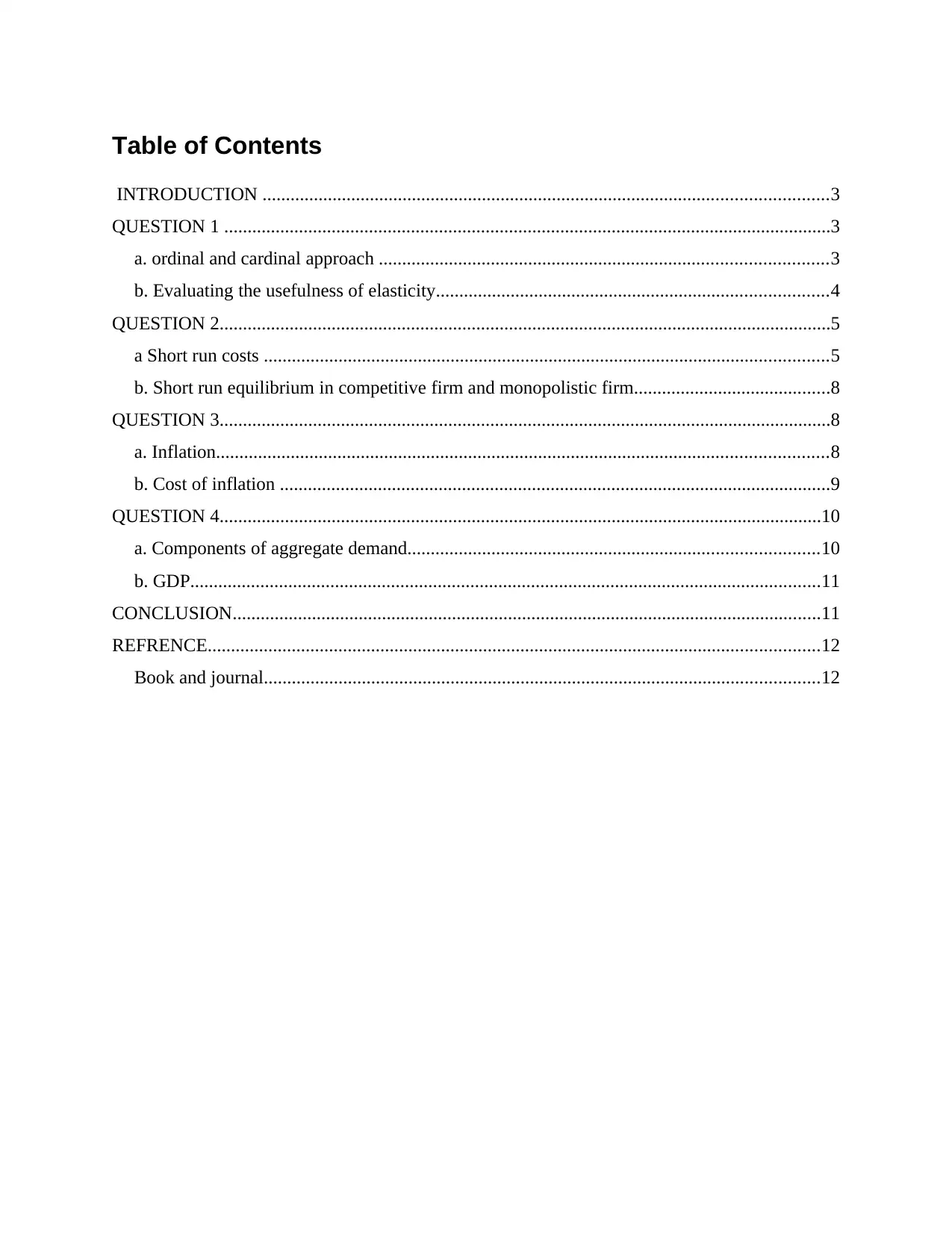
Table of Contents
INTRODUCTION .........................................................................................................................3
QUESTION 1 ..................................................................................................................................3
a. ordinal and cardinal approach ................................................................................................3
b. Evaluating the usefulness of elasticity....................................................................................4
QUESTION 2...................................................................................................................................5
a Short run costs .........................................................................................................................5
b. Short run equilibrium in competitive firm and monopolistic firm..........................................8
QUESTION 3...................................................................................................................................8
a. Inflation...................................................................................................................................8
b. Cost of inflation ......................................................................................................................9
QUESTION 4.................................................................................................................................10
a. Components of aggregate demand........................................................................................10
b. GDP.......................................................................................................................................11
CONCLUSION..............................................................................................................................11
REFRENCE...................................................................................................................................12
Book and journal.......................................................................................................................12
INTRODUCTION .........................................................................................................................3
QUESTION 1 ..................................................................................................................................3
a. ordinal and cardinal approach ................................................................................................3
b. Evaluating the usefulness of elasticity....................................................................................4
QUESTION 2...................................................................................................................................5
a Short run costs .........................................................................................................................5
b. Short run equilibrium in competitive firm and monopolistic firm..........................................8
QUESTION 3...................................................................................................................................8
a. Inflation...................................................................................................................................8
b. Cost of inflation ......................................................................................................................9
QUESTION 4.................................................................................................................................10
a. Components of aggregate demand........................................................................................10
b. GDP.......................................................................................................................................11
CONCLUSION..............................................................................................................................11
REFRENCE...................................................................................................................................12
Book and journal.......................................................................................................................12
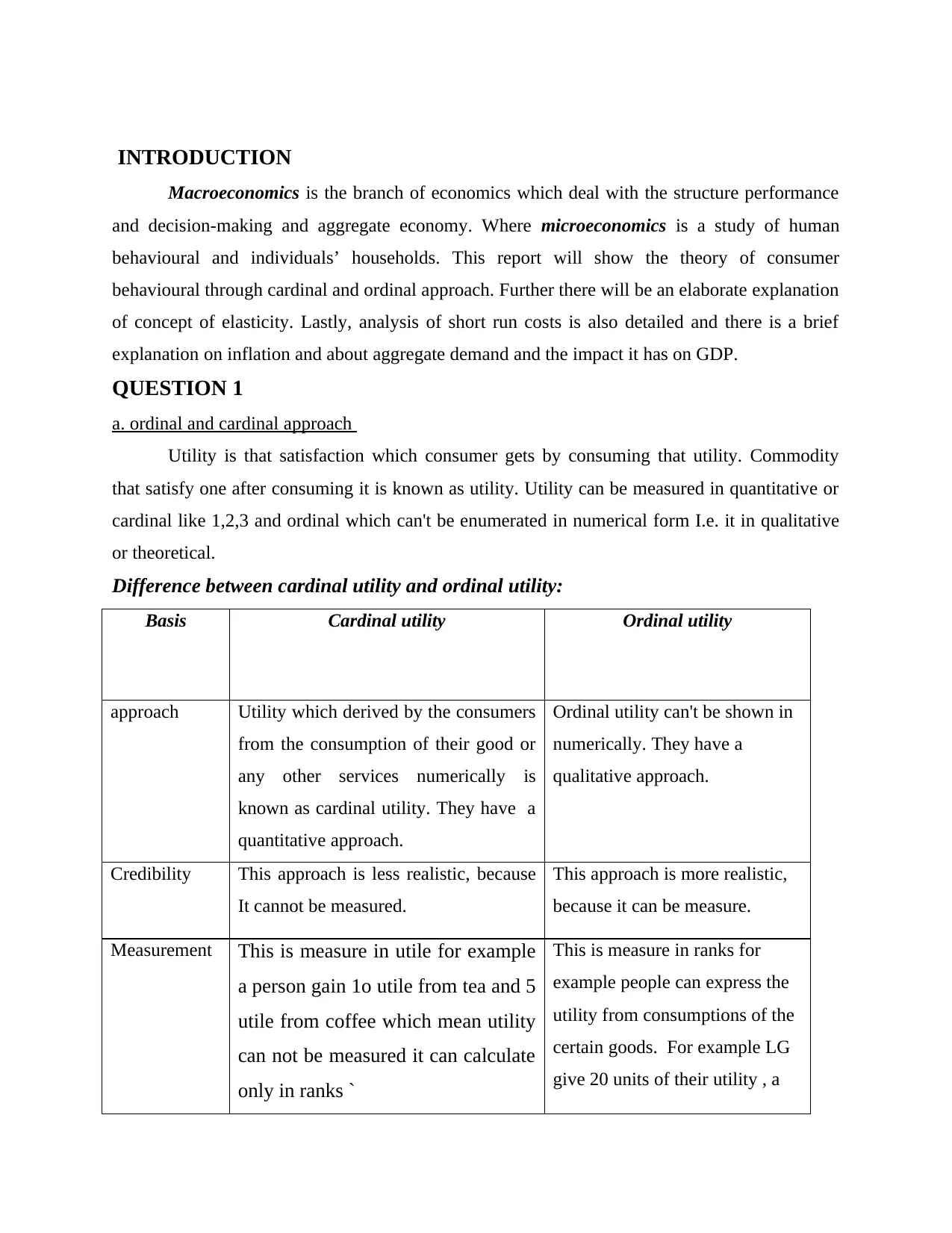
INTRODUCTION
Macroeconomics is the branch of economics which deal with the structure performance
and decision-making and aggregate economy. Where microeconomics is a study of human
behavioural and individuals’ households. This report will show the theory of consumer
behavioural through cardinal and ordinal approach. Further there will be an elaborate explanation
of concept of elasticity. Lastly, analysis of short run costs is also detailed and there is a brief
explanation on inflation and about aggregate demand and the impact it has on GDP.
QUESTION 1
a. ordinal and cardinal approach
Utility is that satisfaction which consumer gets by consuming that utility. Commodity
that satisfy one after consuming it is known as utility. Utility can be measured in quantitative or
cardinal like 1,2,3 and ordinal which can't be enumerated in numerical form I.e. it in qualitative
or theoretical.
Difference between cardinal utility and ordinal utility:
Basis Cardinal utility Ordinal utility
approach Utility which derived by the consumers
from the consumption of their good or
any other services numerically is
known as cardinal utility. They have a
quantitative approach.
Ordinal utility can't be shown in
numerically. They have a
qualitative approach.
Credibility This approach is less realistic, because
It cannot be measured.
This approach is more realistic,
because it can be measure.
Measurement This is measure in utile for example
a person gain 1o utile from tea and 5
utile from coffee which mean utility
can not be measured it can calculate
only in ranks `
This is measure in ranks for
example people can express the
utility from consumptions of the
certain goods. For example LG
give 20 units of their utility , a
Macroeconomics is the branch of economics which deal with the structure performance
and decision-making and aggregate economy. Where microeconomics is a study of human
behavioural and individuals’ households. This report will show the theory of consumer
behavioural through cardinal and ordinal approach. Further there will be an elaborate explanation
of concept of elasticity. Lastly, analysis of short run costs is also detailed and there is a brief
explanation on inflation and about aggregate demand and the impact it has on GDP.
QUESTION 1
a. ordinal and cardinal approach
Utility is that satisfaction which consumer gets by consuming that utility. Commodity
that satisfy one after consuming it is known as utility. Utility can be measured in quantitative or
cardinal like 1,2,3 and ordinal which can't be enumerated in numerical form I.e. it in qualitative
or theoretical.
Difference between cardinal utility and ordinal utility:
Basis Cardinal utility Ordinal utility
approach Utility which derived by the consumers
from the consumption of their good or
any other services numerically is
known as cardinal utility. They have a
quantitative approach.
Ordinal utility can't be shown in
numerically. They have a
qualitative approach.
Credibility This approach is less realistic, because
It cannot be measured.
This approach is more realistic,
because it can be measure.
Measurement This is measure in utile for example
a person gain 1o utile from tea and 5
utile from coffee which mean utility
can not be measured it can calculate
only in ranks `
This is measure in ranks for
example people can express the
utility from consumptions of the
certain goods. For example LG
give 20 units of their utility , a
⊘ This is a preview!⊘
Do you want full access?
Subscribe today to unlock all pages.

Trusted by 1+ million students worldwide
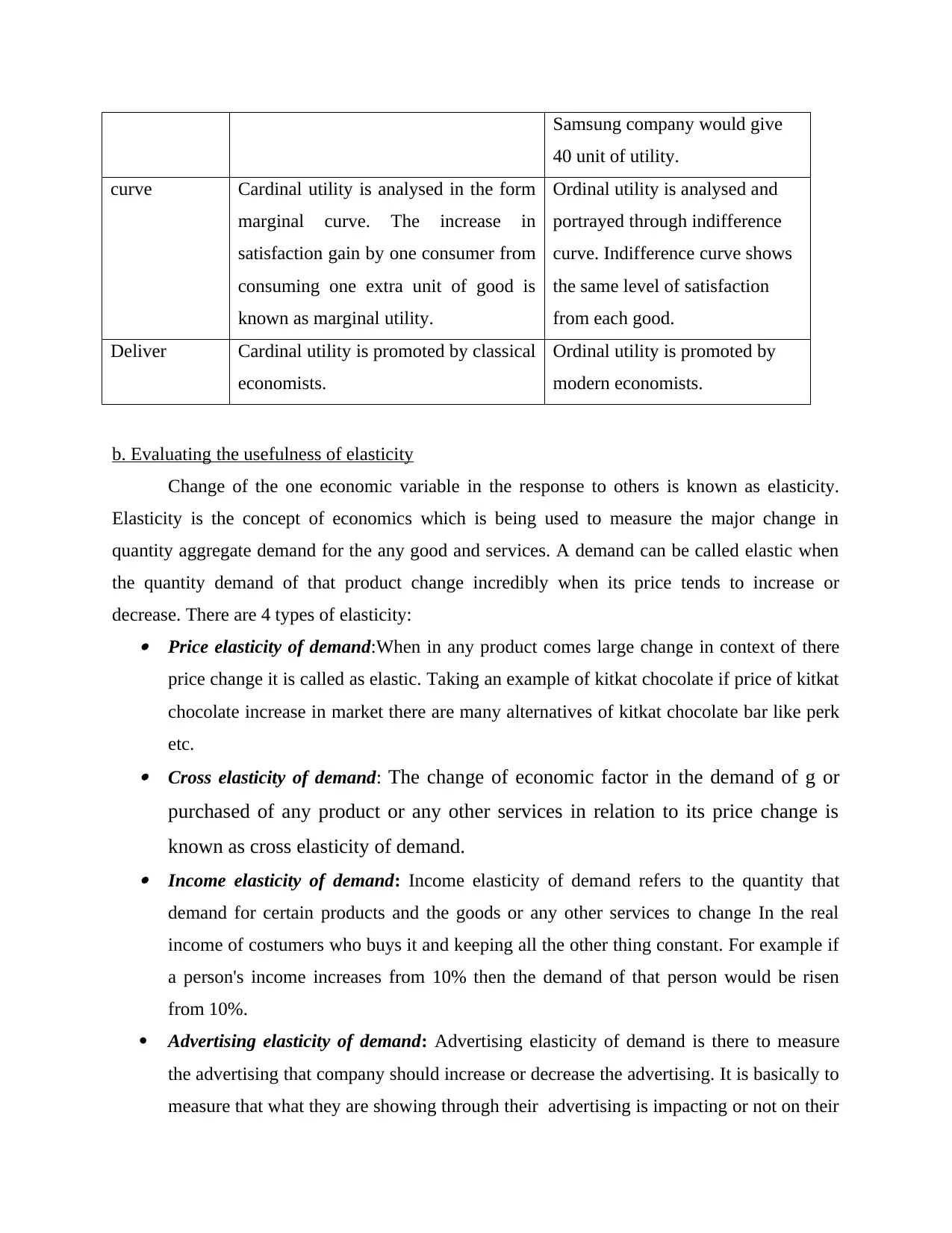
Samsung company would give
40 unit of utility.
curve Cardinal utility is analysed in the form
marginal curve. The increase in
satisfaction gain by one consumer from
consuming one extra unit of good is
known as marginal utility.
Ordinal utility is analysed and
portrayed through indifference
curve. Indifference curve shows
the same level of satisfaction
from each good.
Deliver Cardinal utility is promoted by classical
economists.
Ordinal utility is promoted by
modern economists.
b. Evaluating the usefulness of elasticity
Change of the one economic variable in the response to others is known as elasticity.
Elasticity is the concept of economics which is being used to measure the major change in
quantity aggregate demand for the any good and services. A demand can be called elastic when
the quantity demand of that product change incredibly when its price tends to increase or
decrease. There are 4 types of elasticity: Price elasticity of demand:When in any product comes large change in context of there
price change it is called as elastic. Taking an example of kitkat chocolate if price of kitkat
chocolate increase in market there are many alternatives of kitkat chocolate bar like perk
etc. Cross elasticity of demand: The change of economic factor in the demand of g or
purchased of any product or any other services in relation to its price change is
known as cross elasticity of demand. Income elasticity of demand: Income elasticity of demand refers to the quantity that
demand for certain products and the goods or any other services to change In the real
income of costumers who buys it and keeping all the other thing constant. For example if
a person's income increases from 10% then the demand of that person would be risen
from 10%.
Advertising elasticity of demand: Advertising elasticity of demand is there to measure
the advertising that company should increase or decrease the advertising. It is basically to
measure that what they are showing through their advertising is impacting or not on their
40 unit of utility.
curve Cardinal utility is analysed in the form
marginal curve. The increase in
satisfaction gain by one consumer from
consuming one extra unit of good is
known as marginal utility.
Ordinal utility is analysed and
portrayed through indifference
curve. Indifference curve shows
the same level of satisfaction
from each good.
Deliver Cardinal utility is promoted by classical
economists.
Ordinal utility is promoted by
modern economists.
b. Evaluating the usefulness of elasticity
Change of the one economic variable in the response to others is known as elasticity.
Elasticity is the concept of economics which is being used to measure the major change in
quantity aggregate demand for the any good and services. A demand can be called elastic when
the quantity demand of that product change incredibly when its price tends to increase or
decrease. There are 4 types of elasticity: Price elasticity of demand:When in any product comes large change in context of there
price change it is called as elastic. Taking an example of kitkat chocolate if price of kitkat
chocolate increase in market there are many alternatives of kitkat chocolate bar like perk
etc. Cross elasticity of demand: The change of economic factor in the demand of g or
purchased of any product or any other services in relation to its price change is
known as cross elasticity of demand. Income elasticity of demand: Income elasticity of demand refers to the quantity that
demand for certain products and the goods or any other services to change In the real
income of costumers who buys it and keeping all the other thing constant. For example if
a person's income increases from 10% then the demand of that person would be risen
from 10%.
Advertising elasticity of demand: Advertising elasticity of demand is there to measure
the advertising that company should increase or decrease the advertising. It is basically to
measure that what they are showing through their advertising is impacting or not on their
Paraphrase This Document
Need a fresh take? Get an instant paraphrase of this document with our AI Paraphraser
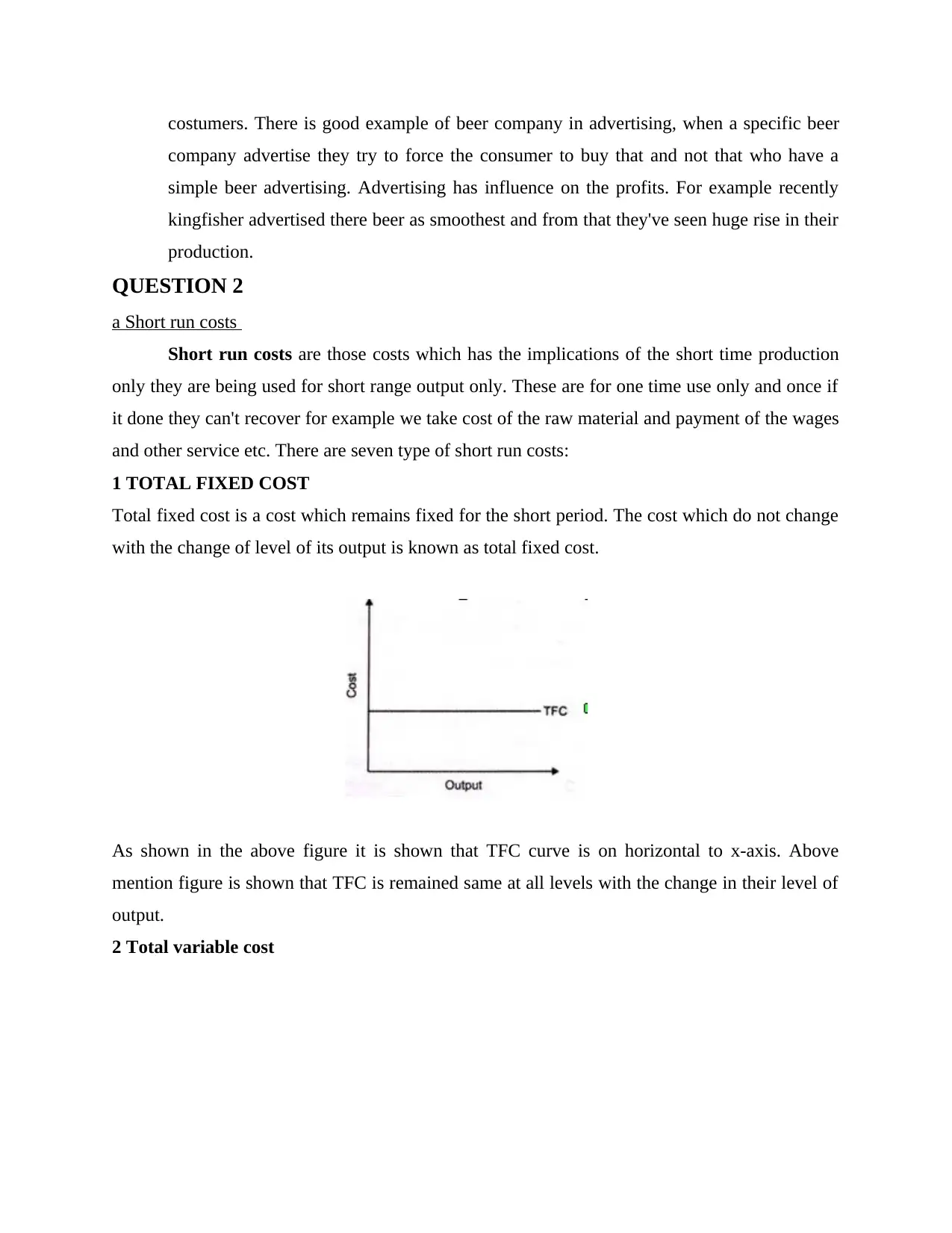
costumers. There is good example of beer company in advertising, when a specific beer
company advertise they try to force the consumer to buy that and not that who have a
simple beer advertising. Advertising has influence on the profits. For example recently
kingfisher advertised there beer as smoothest and from that they've seen huge rise in their
production.
QUESTION 2
a Short run costs
Short run costs are those costs which has the implications of the short time production
only they are being used for short range output only. These are for one time use only and once if
it done they can't recover for example we take cost of the raw material and payment of the wages
and other service etc. There are seven type of short run costs:
1 TOTAL FIXED COST
Total fixed cost is a cost which remains fixed for the short period. The cost which do not change
with the change of level of its output is known as total fixed cost.
As shown in the above figure it is shown that TFC curve is on horizontal to x-axis. Above
mention figure is shown that TFC is remained same at all levels with the change in their level of
output.
2 Total variable cost
company advertise they try to force the consumer to buy that and not that who have a
simple beer advertising. Advertising has influence on the profits. For example recently
kingfisher advertised there beer as smoothest and from that they've seen huge rise in their
production.
QUESTION 2
a Short run costs
Short run costs are those costs which has the implications of the short time production
only they are being used for short range output only. These are for one time use only and once if
it done they can't recover for example we take cost of the raw material and payment of the wages
and other service etc. There are seven type of short run costs:
1 TOTAL FIXED COST
Total fixed cost is a cost which remains fixed for the short period. The cost which do not change
with the change of level of its output is known as total fixed cost.
As shown in the above figure it is shown that TFC curve is on horizontal to x-axis. Above
mention figure is shown that TFC is remained same at all levels with the change in their level of
output.
2 Total variable cost
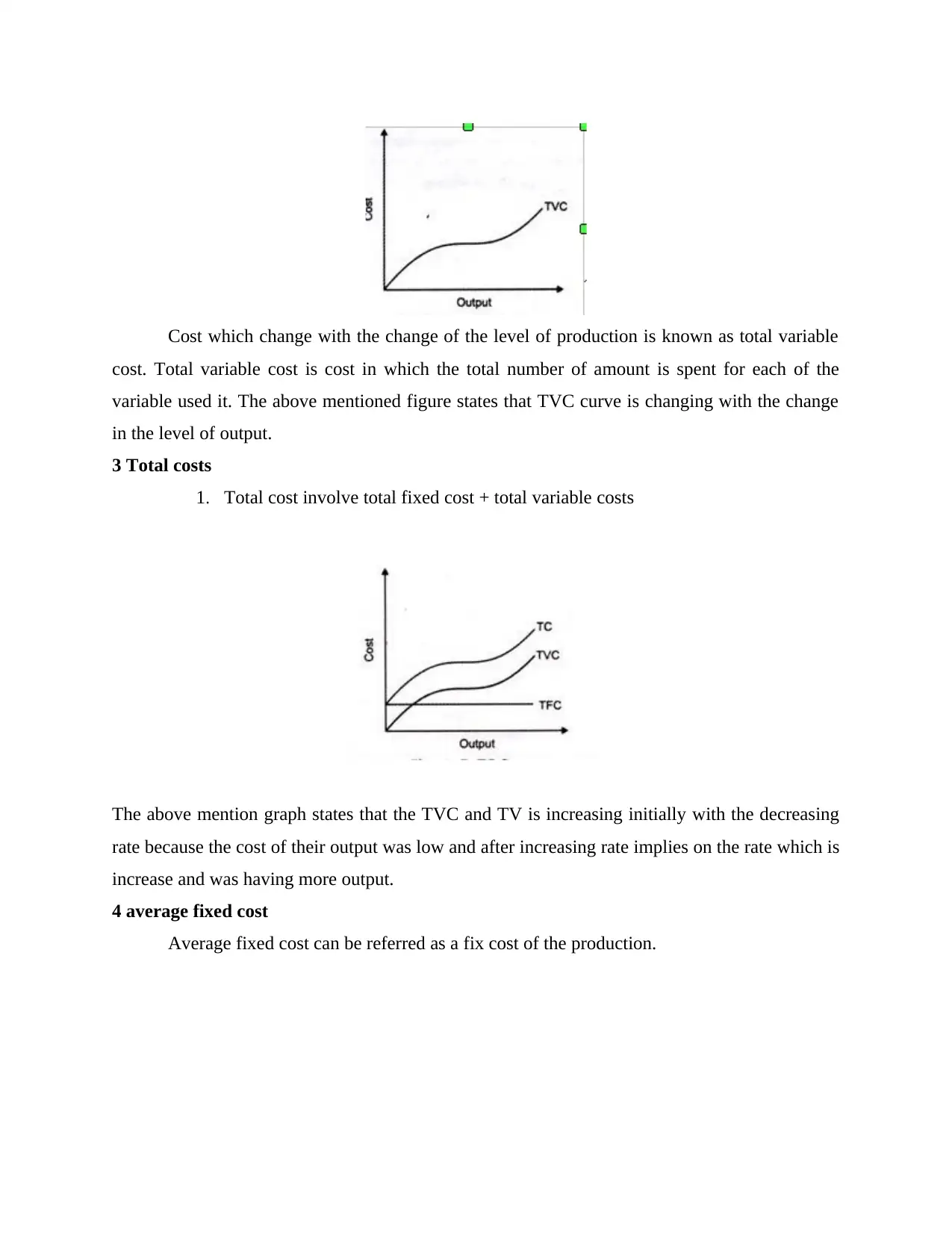
Cost which change with the change of the level of production is known as total variable
cost. Total variable cost is cost in which the total number of amount is spent for each of the
variable used it. The above mentioned figure states that TVC curve is changing with the change
in the level of output.
3 Total costs
1. Total cost involve total fixed cost + total variable costs
The above mention graph states that the TVC and TV is increasing initially with the decreasing
rate because the cost of their output was low and after increasing rate implies on the rate which is
increase and was having more output.
4 average fixed cost
Average fixed cost can be referred as a fix cost of the production.
cost. Total variable cost is cost in which the total number of amount is spent for each of the
variable used it. The above mentioned figure states that TVC curve is changing with the change
in the level of output.
3 Total costs
1. Total cost involve total fixed cost + total variable costs
The above mention graph states that the TVC and TV is increasing initially with the decreasing
rate because the cost of their output was low and after increasing rate implies on the rate which is
increase and was having more output.
4 average fixed cost
Average fixed cost can be referred as a fix cost of the production.
⊘ This is a preview!⊘
Do you want full access?
Subscribe today to unlock all pages.

Trusted by 1+ million students worldwide
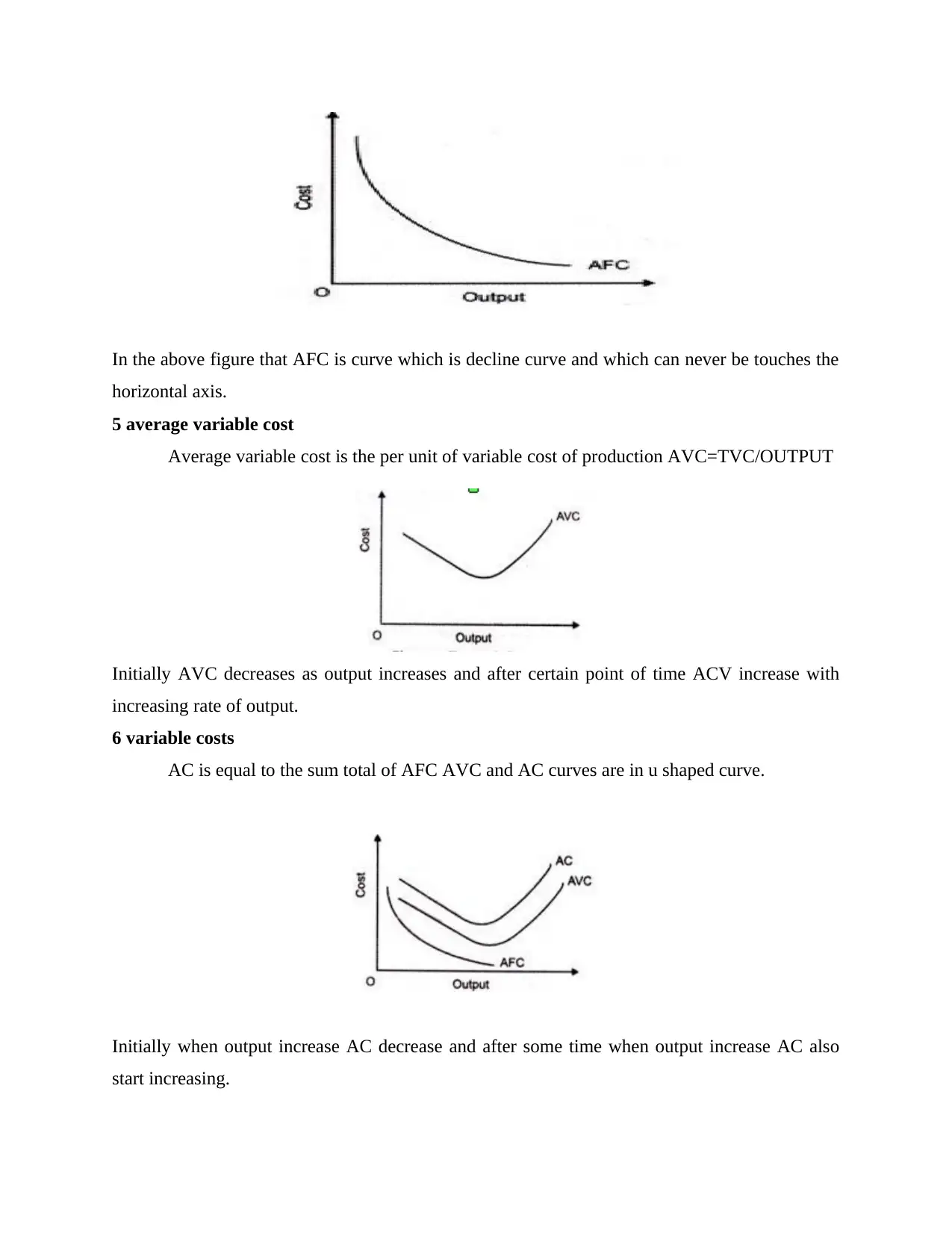
In the above figure that AFC is curve which is decline curve and which can never be touches the
horizontal axis.
5 average variable cost
Average variable cost is the per unit of variable cost of production AVC=TVC/OUTPUT
Initially AVC decreases as output increases and after certain point of time ACV increase with
increasing rate of output.
6 variable costs
AC is equal to the sum total of AFC AVC and AC curves are in u shaped curve.
Initially when output increase AC decrease and after some time when output increase AC also
start increasing.
horizontal axis.
5 average variable cost
Average variable cost is the per unit of variable cost of production AVC=TVC/OUTPUT
Initially AVC decreases as output increases and after certain point of time ACV increase with
increasing rate of output.
6 variable costs
AC is equal to the sum total of AFC AVC and AC curves are in u shaped curve.
Initially when output increase AC decrease and after some time when output increase AC also
start increasing.
Paraphrase This Document
Need a fresh take? Get an instant paraphrase of this document with our AI Paraphraser
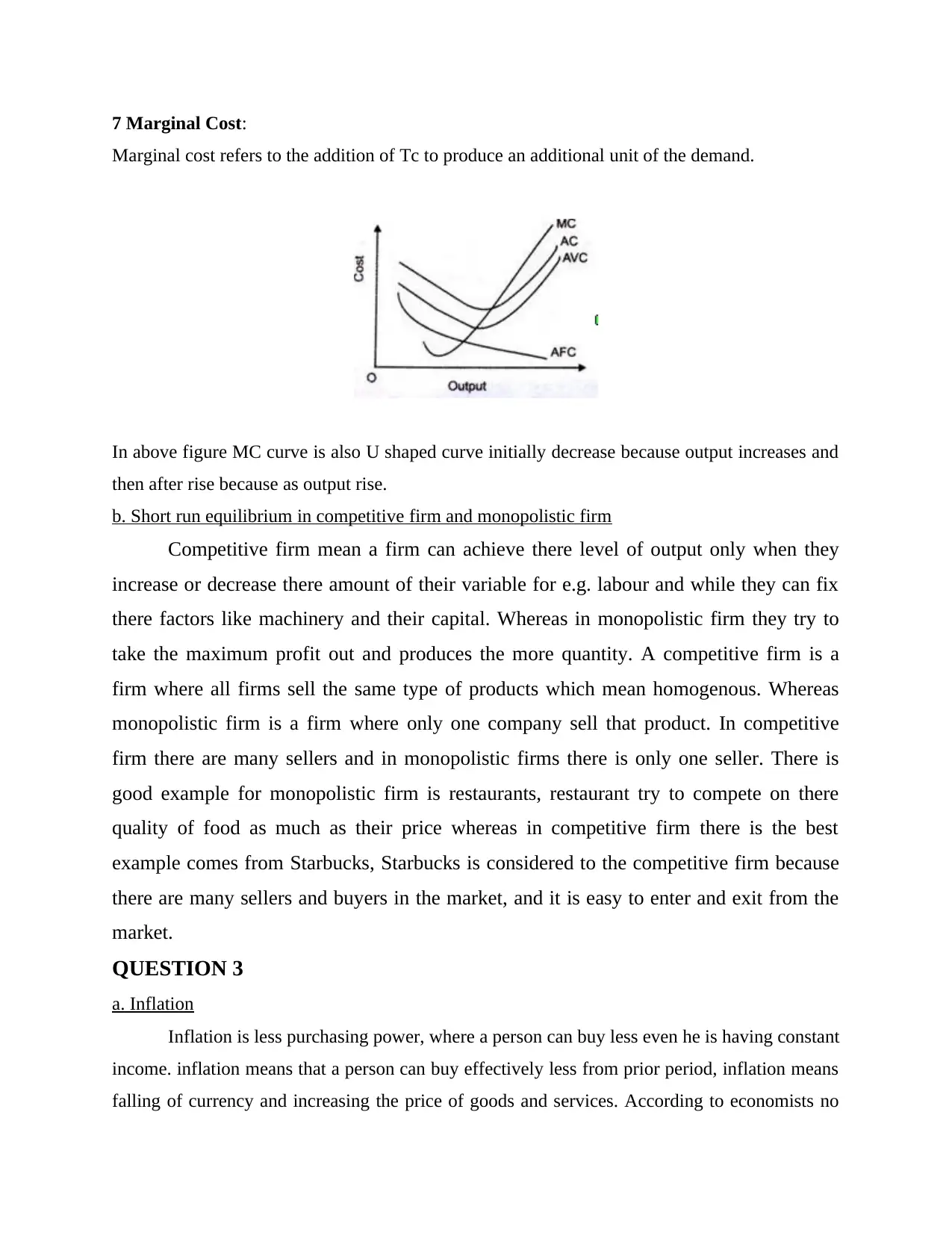
7 Marginal Cost:
Marginal cost refers to the addition of Tc to produce an additional unit of the demand.
In above figure MC curve is also U shaped curve initially decrease because output increases and
then after rise because as output rise.
b. Short run equilibrium in competitive firm and monopolistic firm
Competitive firm mean a firm can achieve there level of output only when they
increase or decrease there amount of their variable for e.g. labour and while they can fix
there factors like machinery and their capital. Whereas in monopolistic firm they try to
take the maximum profit out and produces the more quantity. A competitive firm is a
firm where all firms sell the same type of products which mean homogenous. Whereas
monopolistic firm is a firm where only one company sell that product. In competitive
firm there are many sellers and in monopolistic firms there is only one seller. There is
good example for monopolistic firm is restaurants, restaurant try to compete on there
quality of food as much as their price whereas in competitive firm there is the best
example comes from Starbucks, Starbucks is considered to the competitive firm because
there are many sellers and buyers in the market, and it is easy to enter and exit from the
market.
QUESTION 3
a. Inflation
Inflation is less purchasing power, where a person can buy less even he is having constant
income. inflation means that a person can buy effectively less from prior period, inflation means
falling of currency and increasing the price of goods and services. According to economists no
Marginal cost refers to the addition of Tc to produce an additional unit of the demand.
In above figure MC curve is also U shaped curve initially decrease because output increases and
then after rise because as output rise.
b. Short run equilibrium in competitive firm and monopolistic firm
Competitive firm mean a firm can achieve there level of output only when they
increase or decrease there amount of their variable for e.g. labour and while they can fix
there factors like machinery and their capital. Whereas in monopolistic firm they try to
take the maximum profit out and produces the more quantity. A competitive firm is a
firm where all firms sell the same type of products which mean homogenous. Whereas
monopolistic firm is a firm where only one company sell that product. In competitive
firm there are many sellers and in monopolistic firms there is only one seller. There is
good example for monopolistic firm is restaurants, restaurant try to compete on there
quality of food as much as their price whereas in competitive firm there is the best
example comes from Starbucks, Starbucks is considered to the competitive firm because
there are many sellers and buyers in the market, and it is easy to enter and exit from the
market.
QUESTION 3
a. Inflation
Inflation is less purchasing power, where a person can buy less even he is having constant
income. inflation means that a person can buy effectively less from prior period, inflation means
falling of currency and increasing the price of goods and services. According to economists no
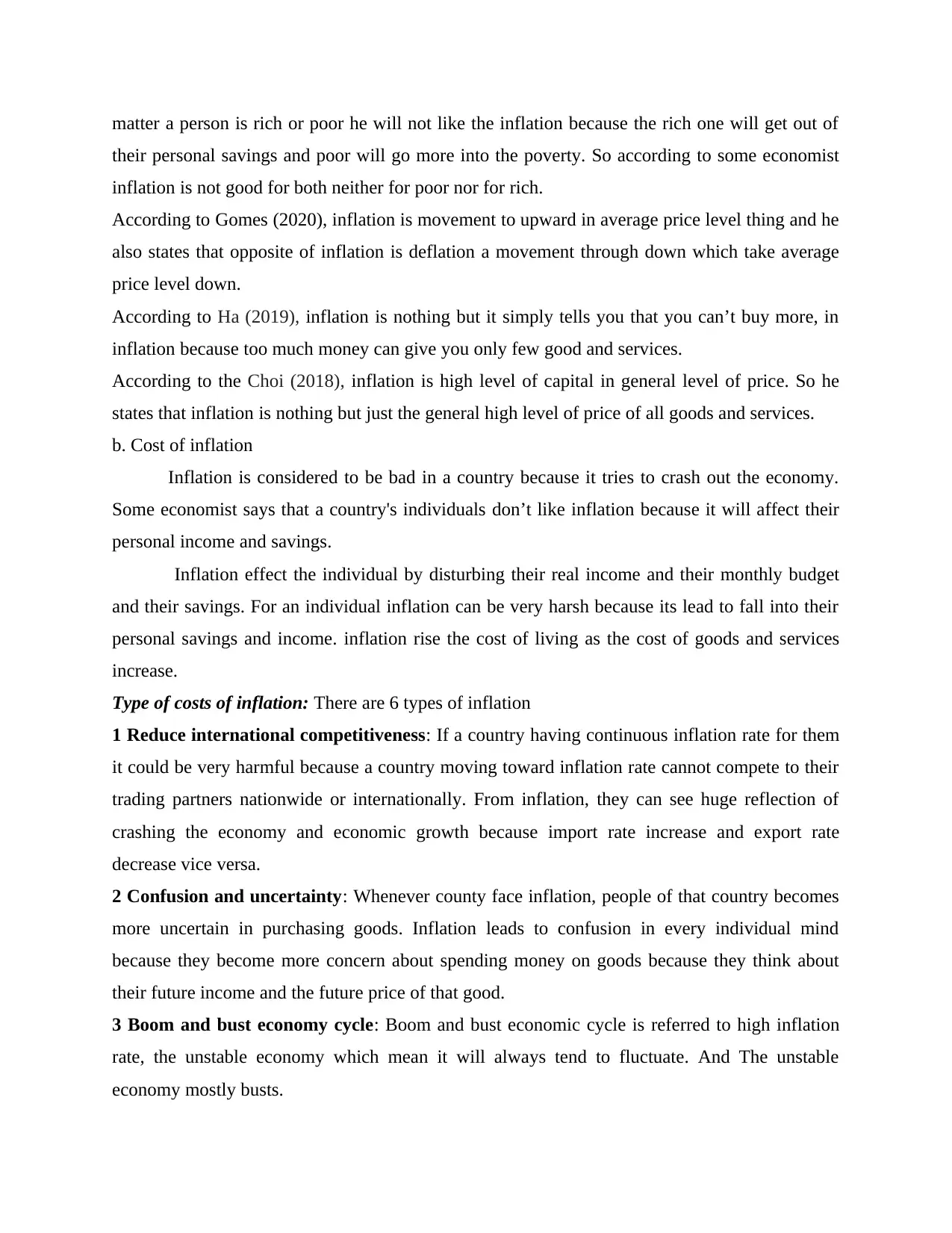
matter a person is rich or poor he will not like the inflation because the rich one will get out of
their personal savings and poor will go more into the poverty. So according to some economist
inflation is not good for both neither for poor nor for rich.
According to Gomes (2020), inflation is movement to upward in average price level thing and he
also states that opposite of inflation is deflation a movement through down which take average
price level down.
According to Ha (2019), inflation is nothing but it simply tells you that you can’t buy more, in
inflation because too much money can give you only few good and services.
According to the Choi (2018), inflation is high level of capital in general level of price. So he
states that inflation is nothing but just the general high level of price of all goods and services.
b. Cost of inflation
Inflation is considered to be bad in a country because it tries to crash out the economy.
Some economist says that a country's individuals don’t like inflation because it will affect their
personal income and savings.
Inflation effect the individual by disturbing their real income and their monthly budget
and their savings. For an individual inflation can be very harsh because its lead to fall into their
personal savings and income. inflation rise the cost of living as the cost of goods and services
increase.
Type of costs of inflation: There are 6 types of inflation
1 Reduce international competitiveness: If a country having continuous inflation rate for them
it could be very harmful because a country moving toward inflation rate cannot compete to their
trading partners nationwide or internationally. From inflation, they can see huge reflection of
crashing the economy and economic growth because import rate increase and export rate
decrease vice versa.
2 Confusion and uncertainty: Whenever county face inflation, people of that country becomes
more uncertain in purchasing goods. Inflation leads to confusion in every individual mind
because they become more concern about spending money on goods because they think about
their future income and the future price of that good.
3 Boom and bust economy cycle: Boom and bust economic cycle is referred to high inflation
rate, the unstable economy which mean it will always tend to fluctuate. And The unstable
economy mostly busts.
their personal savings and poor will go more into the poverty. So according to some economist
inflation is not good for both neither for poor nor for rich.
According to Gomes (2020), inflation is movement to upward in average price level thing and he
also states that opposite of inflation is deflation a movement through down which take average
price level down.
According to Ha (2019), inflation is nothing but it simply tells you that you can’t buy more, in
inflation because too much money can give you only few good and services.
According to the Choi (2018), inflation is high level of capital in general level of price. So he
states that inflation is nothing but just the general high level of price of all goods and services.
b. Cost of inflation
Inflation is considered to be bad in a country because it tries to crash out the economy.
Some economist says that a country's individuals don’t like inflation because it will affect their
personal income and savings.
Inflation effect the individual by disturbing their real income and their monthly budget
and their savings. For an individual inflation can be very harsh because its lead to fall into their
personal savings and income. inflation rise the cost of living as the cost of goods and services
increase.
Type of costs of inflation: There are 6 types of inflation
1 Reduce international competitiveness: If a country having continuous inflation rate for them
it could be very harmful because a country moving toward inflation rate cannot compete to their
trading partners nationwide or internationally. From inflation, they can see huge reflection of
crashing the economy and economic growth because import rate increase and export rate
decrease vice versa.
2 Confusion and uncertainty: Whenever county face inflation, people of that country becomes
more uncertain in purchasing goods. Inflation leads to confusion in every individual mind
because they become more concern about spending money on goods because they think about
their future income and the future price of that good.
3 Boom and bust economy cycle: Boom and bust economic cycle is referred to high inflation
rate, the unstable economy which mean it will always tend to fluctuate. And The unstable
economy mostly busts.
⊘ This is a preview!⊘
Do you want full access?
Subscribe today to unlock all pages.

Trusted by 1+ million students worldwide
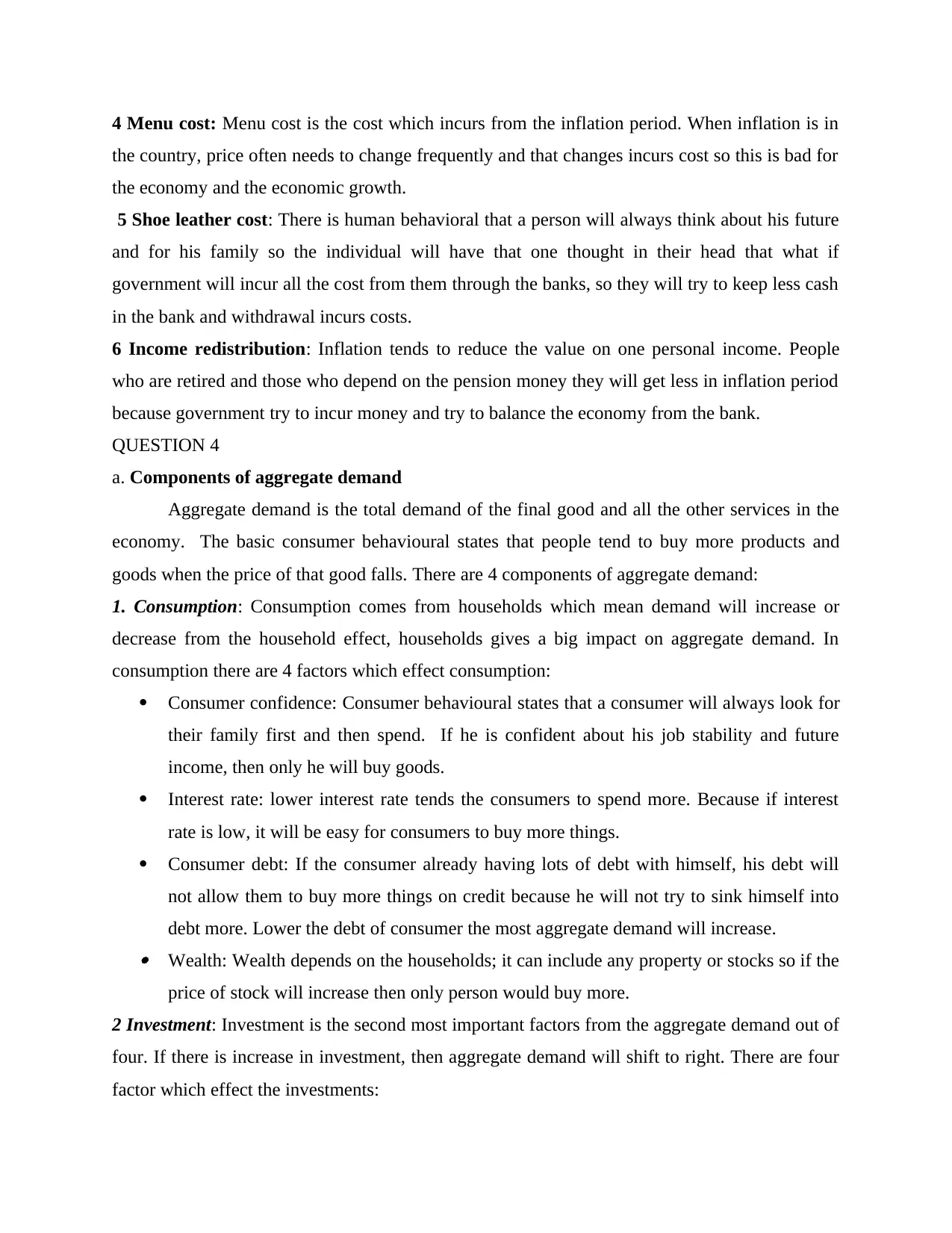
4 Menu cost: Menu cost is the cost which incurs from the inflation period. When inflation is in
the country, price often needs to change frequently and that changes incurs cost so this is bad for
the economy and the economic growth.
5 Shoe leather cost: There is human behavioral that a person will always think about his future
and for his family so the individual will have that one thought in their head that what if
government will incur all the cost from them through the banks, so they will try to keep less cash
in the bank and withdrawal incurs costs.
6 Income redistribution: Inflation tends to reduce the value on one personal income. People
who are retired and those who depend on the pension money they will get less in inflation period
because government try to incur money and try to balance the economy from the bank.
QUESTION 4
a. Components of aggregate demand
Aggregate demand is the total demand of the final good and all the other services in the
economy. The basic consumer behavioural states that people tend to buy more products and
goods when the price of that good falls. There are 4 components of aggregate demand:
1. Consumption: Consumption comes from households which mean demand will increase or
decrease from the household effect, households gives a big impact on aggregate demand. In
consumption there are 4 factors which effect consumption:
Consumer confidence: Consumer behavioural states that a consumer will always look for
their family first and then spend. If he is confident about his job stability and future
income, then only he will buy goods.
Interest rate: lower interest rate tends the consumers to spend more. Because if interest
rate is low, it will be easy for consumers to buy more things.
Consumer debt: If the consumer already having lots of debt with himself, his debt will
not allow them to buy more things on credit because he will not try to sink himself into
debt more. Lower the debt of consumer the most aggregate demand will increase. Wealth: Wealth depends on the households; it can include any property or stocks so if the
price of stock will increase then only person would buy more.
2 Investment: Investment is the second most important factors from the aggregate demand out of
four. If there is increase in investment, then aggregate demand will shift to right. There are four
factor which effect the investments:
the country, price often needs to change frequently and that changes incurs cost so this is bad for
the economy and the economic growth.
5 Shoe leather cost: There is human behavioral that a person will always think about his future
and for his family so the individual will have that one thought in their head that what if
government will incur all the cost from them through the banks, so they will try to keep less cash
in the bank and withdrawal incurs costs.
6 Income redistribution: Inflation tends to reduce the value on one personal income. People
who are retired and those who depend on the pension money they will get less in inflation period
because government try to incur money and try to balance the economy from the bank.
QUESTION 4
a. Components of aggregate demand
Aggregate demand is the total demand of the final good and all the other services in the
economy. The basic consumer behavioural states that people tend to buy more products and
goods when the price of that good falls. There are 4 components of aggregate demand:
1. Consumption: Consumption comes from households which mean demand will increase or
decrease from the household effect, households gives a big impact on aggregate demand. In
consumption there are 4 factors which effect consumption:
Consumer confidence: Consumer behavioural states that a consumer will always look for
their family first and then spend. If he is confident about his job stability and future
income, then only he will buy goods.
Interest rate: lower interest rate tends the consumers to spend more. Because if interest
rate is low, it will be easy for consumers to buy more things.
Consumer debt: If the consumer already having lots of debt with himself, his debt will
not allow them to buy more things on credit because he will not try to sink himself into
debt more. Lower the debt of consumer the most aggregate demand will increase. Wealth: Wealth depends on the households; it can include any property or stocks so if the
price of stock will increase then only person would buy more.
2 Investment: Investment is the second most important factors from the aggregate demand out of
four. If there is increase in investment, then aggregate demand will shift to right. There are four
factor which effect the investments:
Paraphrase This Document
Need a fresh take? Get an instant paraphrase of this document with our AI Paraphraser
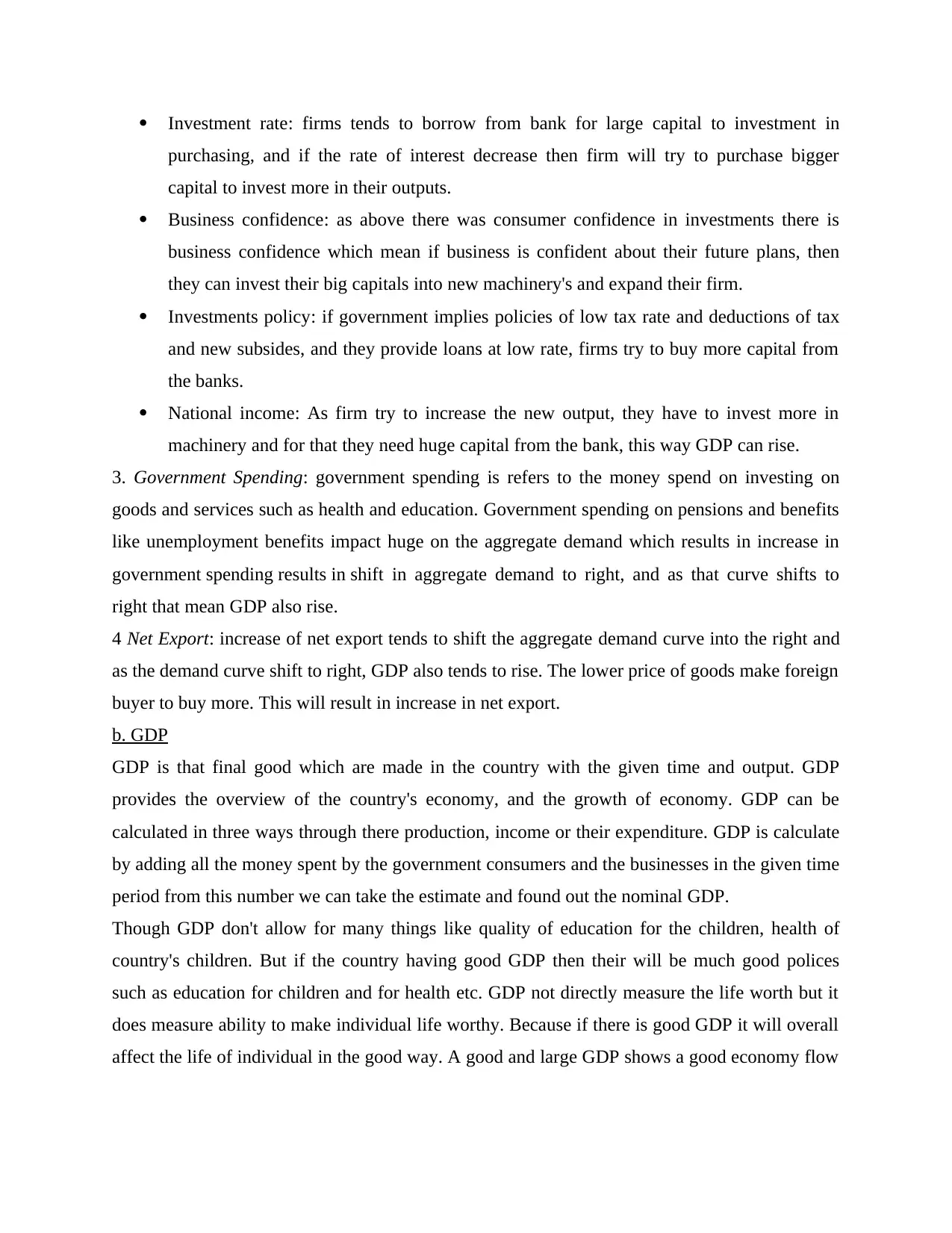
Investment rate: firms tends to borrow from bank for large capital to investment in
purchasing, and if the rate of interest decrease then firm will try to purchase bigger
capital to invest more in their outputs.
Business confidence: as above there was consumer confidence in investments there is
business confidence which mean if business is confident about their future plans, then
they can invest their big capitals into new machinery's and expand their firm.
Investments policy: if government implies policies of low tax rate and deductions of tax
and new subsides, and they provide loans at low rate, firms try to buy more capital from
the banks.
National income: As firm try to increase the new output, they have to invest more in
machinery and for that they need huge capital from the bank, this way GDP can rise.
3. Government Spending: government spending is refers to the money spend on investing on
goods and services such as health and education. Government spending on pensions and benefits
like unemployment benefits impact huge on the aggregate demand which results in increase in
government spending results in shift in aggregate demand to right, and as that curve shifts to
right that mean GDP also rise.
4 Net Export: increase of net export tends to shift the aggregate demand curve into the right and
as the demand curve shift to right, GDP also tends to rise. The lower price of goods make foreign
buyer to buy more. This will result in increase in net export.
b. GDP
GDP is that final good which are made in the country with the given time and output. GDP
provides the overview of the country's economy, and the growth of economy. GDP can be
calculated in three ways through there production, income or their expenditure. GDP is calculate
by adding all the money spent by the government consumers and the businesses in the given time
period from this number we can take the estimate and found out the nominal GDP.
Though GDP don't allow for many things like quality of education for the children, health of
country's children. But if the country having good GDP then their will be much good polices
such as education for children and for health etc. GDP not directly measure the life worth but it
does measure ability to make individual life worthy. Because if there is good GDP it will overall
affect the life of individual in the good way. A good and large GDP shows a good economy flow
purchasing, and if the rate of interest decrease then firm will try to purchase bigger
capital to invest more in their outputs.
Business confidence: as above there was consumer confidence in investments there is
business confidence which mean if business is confident about their future plans, then
they can invest their big capitals into new machinery's and expand their firm.
Investments policy: if government implies policies of low tax rate and deductions of tax
and new subsides, and they provide loans at low rate, firms try to buy more capital from
the banks.
National income: As firm try to increase the new output, they have to invest more in
machinery and for that they need huge capital from the bank, this way GDP can rise.
3. Government Spending: government spending is refers to the money spend on investing on
goods and services such as health and education. Government spending on pensions and benefits
like unemployment benefits impact huge on the aggregate demand which results in increase in
government spending results in shift in aggregate demand to right, and as that curve shifts to
right that mean GDP also rise.
4 Net Export: increase of net export tends to shift the aggregate demand curve into the right and
as the demand curve shift to right, GDP also tends to rise. The lower price of goods make foreign
buyer to buy more. This will result in increase in net export.
b. GDP
GDP is that final good which are made in the country with the given time and output. GDP
provides the overview of the country's economy, and the growth of economy. GDP can be
calculated in three ways through there production, income or their expenditure. GDP is calculate
by adding all the money spent by the government consumers and the businesses in the given time
period from this number we can take the estimate and found out the nominal GDP.
Though GDP don't allow for many things like quality of education for the children, health of
country's children. But if the country having good GDP then their will be much good polices
such as education for children and for health etc. GDP not directly measure the life worth but it
does measure ability to make individual life worthy. Because if there is good GDP it will overall
affect the life of individual in the good way. A good and large GDP shows a good economy flow
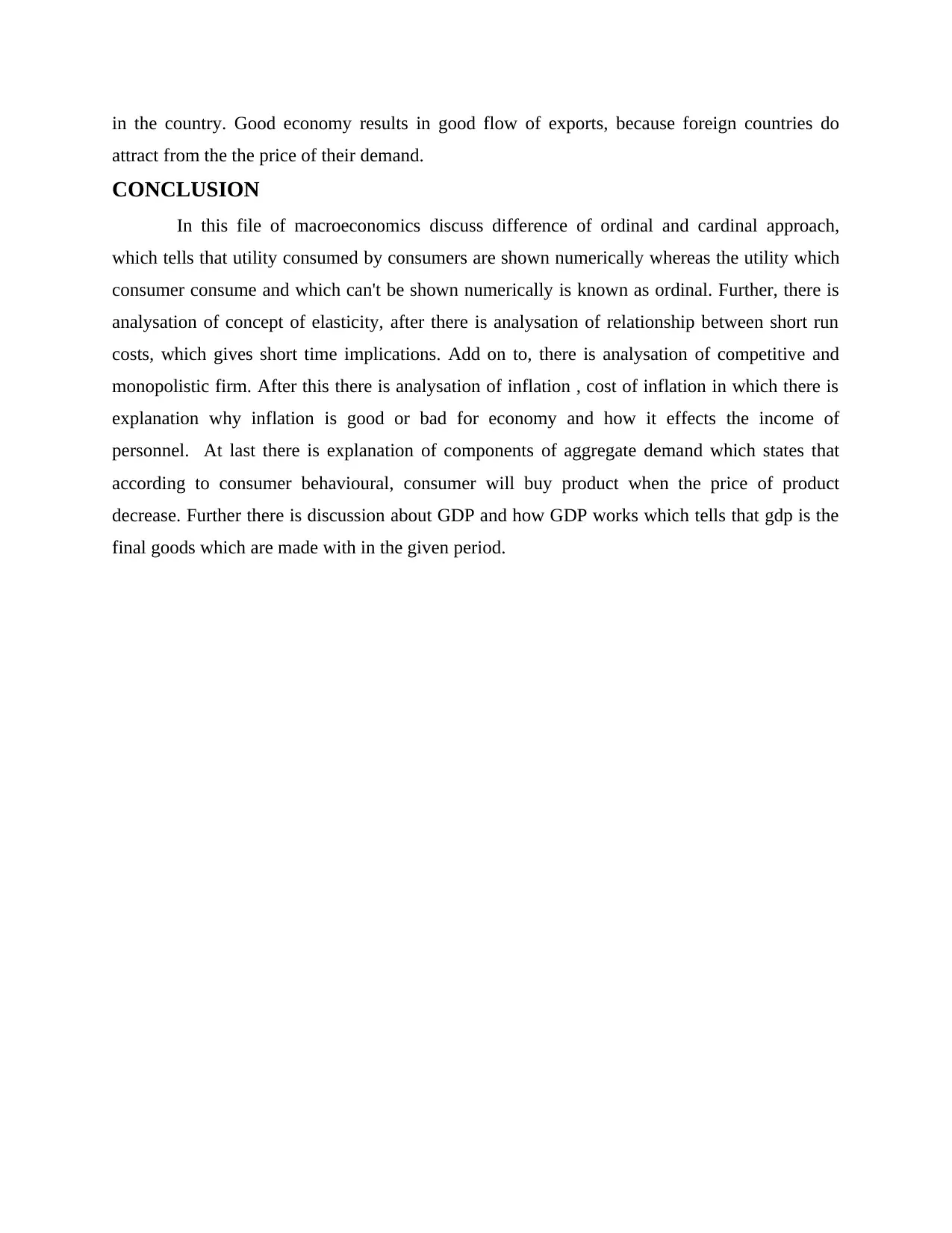
in the country. Good economy results in good flow of exports, because foreign countries do
attract from the the price of their demand.
CONCLUSION
In this file of macroeconomics discuss difference of ordinal and cardinal approach,
which tells that utility consumed by consumers are shown numerically whereas the utility which
consumer consume and which can't be shown numerically is known as ordinal. Further, there is
analysation of concept of elasticity, after there is analysation of relationship between short run
costs, which gives short time implications. Add on to, there is analysation of competitive and
monopolistic firm. After this there is analysation of inflation , cost of inflation in which there is
explanation why inflation is good or bad for economy and how it effects the income of
personnel. At last there is explanation of components of aggregate demand which states that
according to consumer behavioural, consumer will buy product when the price of product
decrease. Further there is discussion about GDP and how GDP works which tells that gdp is the
final goods which are made with in the given period.
attract from the the price of their demand.
CONCLUSION
In this file of macroeconomics discuss difference of ordinal and cardinal approach,
which tells that utility consumed by consumers are shown numerically whereas the utility which
consumer consume and which can't be shown numerically is known as ordinal. Further, there is
analysation of concept of elasticity, after there is analysation of relationship between short run
costs, which gives short time implications. Add on to, there is analysation of competitive and
monopolistic firm. After this there is analysation of inflation , cost of inflation in which there is
explanation why inflation is good or bad for economy and how it effects the income of
personnel. At last there is explanation of components of aggregate demand which states that
according to consumer behavioural, consumer will buy product when the price of product
decrease. Further there is discussion about GDP and how GDP works which tells that gdp is the
final goods which are made with in the given period.
⊘ This is a preview!⊘
Do you want full access?
Subscribe today to unlock all pages.

Trusted by 1+ million students worldwide
1 out of 14
Related Documents
Your All-in-One AI-Powered Toolkit for Academic Success.
+13062052269
info@desklib.com
Available 24*7 on WhatsApp / Email
![[object Object]](/_next/static/media/star-bottom.7253800d.svg)
Unlock your academic potential
Copyright © 2020–2025 A2Z Services. All Rights Reserved. Developed and managed by ZUCOL.





